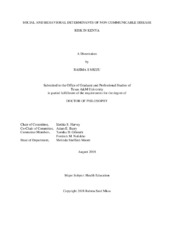| dc.description.abstract | More than half, 75%, of global deaths from non-communicable diseases (NCDs) occur in low and middle-income countries (LMICs). In Kenya, there is evidence of increasing prevalence of NCDs and risk factors such as overweight and obesity, unhealthy diet and inadequate physical activity. The purpose of this dissertation was to: 1) To examine national prevalence and correlates of overweight and obesity in Kenya, 2) To investigate the relationship between fruit and vegetable (FV) intake and NCDs (obesity, type 2 diabetes, and hypertension), and 3) To utilize syndemic theory to identify individuals with multiple NCDs and risk factors.
This cross-sectional study utilized secondary data from the 2015 Kenya WHO Stepwise Survey. A total of 4350 adults were analyzed using descriptive statistics, logistic regression, structural equation modelling, and latent class analysis.
This dissertation found that 28.09% of the sample was overweight or obese. Women, completing primary education or more, being middle wealth category or higher, and aging were significantly associated with overweight or obese. Only 6% of the sample consumed adequate FV a day as recommended by the World Health Organization. A conceptual model of the relationship between FV and NCDs showed differing paths associated by demographic characteristics. Latent class analysis resulted in demonstrated higher probability of NCD risk among individuals residing in urban areas, high education, and high wealth status.
The results of this dissertation support literature of growing burden of NCDs and risk factors in Kenya and similar LMICs. The results suggest that tailored interventions that consider both behavioral and ecologic leverage points are needed to tackle NCDs in Kenya. | en |


